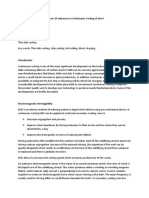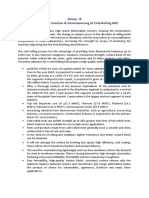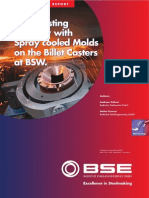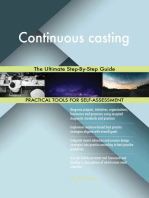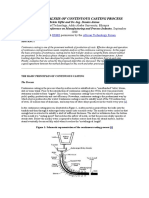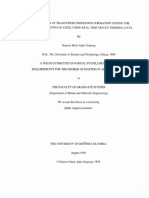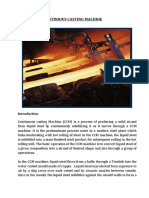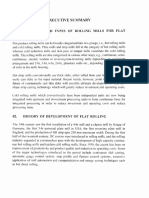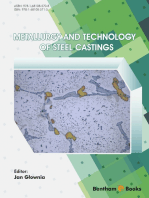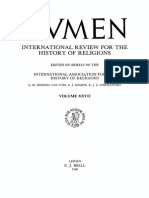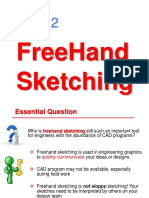Continuous Roll Casting of Aluminium
Continuous Roll Casting of Aluminium
Uploaded by
Luis HernandezCopyright:
Available Formats
Continuous Roll Casting of Aluminium
Continuous Roll Casting of Aluminium
Uploaded by
Luis HernandezCopyright
Available Formats
Share this document
Did you find this document useful?
Is this content inappropriate?
Copyright:
Available Formats
Continuous Roll Casting of Aluminium
Continuous Roll Casting of Aluminium
Uploaded by
Luis HernandezCopyright:
Available Formats
E. KRSTI] VUKELJA, I. DUPLAN^I], B.
LELA ISSN 0543-5846
METABK 49(2) 115-118 (2010)
UDC – UDK 669.715:621.74.047=111
CONTINUOUS ROLL CASTING OF
ALUMINIUM ALLOYS– CASTING PARAMETERS ANALYSIS
Received – Prispjelo: 2008-12-24
Accepted – Prihva}eno: 2009-09-10
Preliminary Note – Prethodno priop}enje
The main goal of the paper was to present the influence of casting parameters on casting conditions and inter-
ference of casting parameters on the final strip characteristics such as constant strip thickness, surface quality
and roughness of aluminum alloys sheet 6,30 to 6,50 mm thick.
The study shows that casting speed, roll force and roll gap should have the greatest influence on the final strip
thickness, and that the examined parameters agree well with the theoretical standpoints.
Key words: continuous roll casting, aluminum alloys, strip casting process, casting parameters
Kontinuirano lijevanje aluminijskih slitina – analiza parametara lijevanja. Temeljni cilj ~lanka je prika-
zati utjecaj parametara lijevanja na uvjete lijevanja i njihov me|usobni utjecaj na postizanje konstantne deblji-
ne trake, kvalitetu i ravno}u povr{ine aluminijskih traka debljine 6,30 do 6,50 mm. Rezultati rada pokazuju da
su glavne utjecajne veli~ine na debljinu trake brzina lijevanja, sila valjanja i razmak valjaka, {to potvr|uju teorij-
ske osnove.
Klju~ne rije~i: kontinuirano lijevanje trake, aluminijske slitine, postupk lijevanja trake, parametri lijevanja
INTRODUCTION
The continuous roll casting process (CRC), consist-
ing of continuous strip casting between rolls, is now
well known. It was introduced by the SCAL Company
(Pechiney Ugine Kuhlmann Group) 60 years ago [1].
The process consists of solidifying aluminum or alumi-
num alloys between the water-cooled rolls of a duo roll-
ing mill. From the moment when solidification is com-
pleted to the moment when the strip is no longer in con-
tact with the rolls, aluminum is submitted to reduction
leading to hot working which is essential for the final Figure 1. View details of solidification and rolling during
quality of the product [1, 2]. the CRC procedure [1-4].
The cast strip is produced horizontally out of the 2,5-5·103 kN/mm. Lubricant is sprayed on the rolls to
caster and is directly coiled while it is still hot. The size prevent the strip from sticking to the roll. The molten
of the coil is adapted to the cold rolling operation. The metal solidifies against the roll and is immediately
strip thickness ranges from 4 to 12 mm.
hot-rolled into the solid strip [1, 2, 5, 6].
Figure 1 shows the principle of the CRC process
In order to produce flow disturbance in the alumi-
[1-4].
num melt at the solidification front, while keeping the
In the aluminum continuous roll casting process
stability of rheological interface, the configuration and
(Figure 1), both solidification and deformation are com-
parameters of this zone are determined through experi-
pleted in a narrow gap between a pair of opposite rotat-
ment and theoretical analysis.
ing rolls.
The testing materials are Al99,2 (AA1235) and
Therefore, the valid zone of this process is the solidi-
fication-deformation zone in the roll gap. Al99,5 (AA8011) aluminum alloys. Their chemical com-
Conventional twin-roll casters for aluminum alloy position measures up to the international deformation
have steel rolls, which have a separating force of aluminum alloys standard. All these materials are able to
form coarse crystals in the roll-casting process. The
E. Krsti} Vukelja, Dental Clinic Zagreb, Zagreb, Croatia,
Al-Ti-B grain refiner in a form of wire was applied. This
I. Duplan~i}, B. Lela, Faculty of Electrical Engineering, Mechanical En- original process, attractive for its well-known operating
gineering and Naval Architecture, University of Split, Croatia simplicity was able to cast strips of about 1 to 2 m wide.
METALURGIJA 49 (2010) 2, 115-118 115
E. KRSTI] VUKELJA et al.: CONTINUOUS ROLL CASTING OF ALUMINIUM ALLOYS – CASTING PARAMETERS ANALYSIS
EXPERIMENTAL PROCEDURES per hour) for roll shell quality I and per one roll pair, and
3,13·106 t/(m·h) for roll shell quality II and per one roll
The present casting work was carried out using a hori- pair [1-11].
zontal twin roll caster designed and built by Pechiney, Expected finite strip quality refers to its thickness,
France [1,2]. Strip production in this facility was carried profile and flatness. The research work was focused on
out by horizontal continuous casting process for alumi- achieving the listed quality characteristics by changing
num casts between pairs of cooled and powered rolls. the casting parameters in respect to the alloy composi-
Working rolls affect rapid melt solidification (crystalliza- tion, and the casting regime and finally comparing these
tion), as well as calibration solidified strip at the default parameters with each other [1-9].
strip thickness by means of hot rolling process.
Strip production process begins in melting furnace
and ends at the strip coiler. For the purposes of cold roll- THE CONTINUOUS ROLL
ing mills, this facility produces strip width from 1020 to CASTING PROCEDURE ANALYSIS - STRIP
1520 mm, and thickness from 6,5 to 8 mm. PRODUCTION ON TWIN ROLL CASTER
The roll diameter is 690 mm at the start, and working During the period of production monitoring, related
width of the roll is about 1740 mm. The metal is fed into to this research, four types of working rolls were used
the rolls by pouring the liquid metal in refractory tip. A AI, BI, CI and DI for steel shell quality I, and AII, BII, CII
tip setback (the distance from the end of the tip to mini- and DII for steel shell quality II. Each of the four types
mum roll separation), of 35-55 mm has been selected listed was used with six roll pairs marked by numbers 2,
depending on the casting configuration. The tip is nar- 3, 4, 5, 6 and 7.
rower than the roll face width and soft side dams are The rolls marked by numbers 2, 3 and 4 have a steel
used to prevent sideways flow of the liquid metal. The shell grade of rolls CMYV (roll shell quality I), and rolls
gap between the bearing chocks is controlled; the size of marked by numbers 5, 6 and 7 have a steel shell grade of
which can be changed during the course of a run. rolls MO22 (roll shell quality II). Chemical composition
Typically, strip cast is 1200-1600 mm wide, and this al- of these two roll shells are shown in Table 2, [7, 8, 12, 14].
lows a total load of 5·103 kN/mm (kilo Newton per milli-
meter in strip width) to be applied. Strip can be cast at Table 2. General roll shell data [7, 8, 12, 14]
rates from 0,95 to 1,50 cm/min and gauges varying from
Roll shell grade Roll shell chemical composition
5,25 to 5,45 mm. Each casting regime has been carried
C Mn Ni Cr Mo V
out with two different alloys Al99,2 (AA1235) and
Al99,5 (AA8011). Casting conditions, for mentioned Rolls 2, 3 and 4 0,1 – 0,6 – 1,0 – 1,0 – 0,1 –
Steel shell grade -
alloys, and strip dimensions are shown in Table 1, [7]. I (CMYV) 0,3 0,8 2,0 2,0 0,3
Rolls 5, 6 and 7 02 – 0,4 – 0,2 – 2,0 – 0,8 – 0,1 –
Table 1. Strip casting parameters for the CRC plant and Steel shell grade
casting alloys Al99,5 (AA8011) and Al99,2 II (MO22) 0,4 0,6 0,4 4,0 1,2 0,3
(AA1235) [7]
Strip dimension Aluminum alloy The activities were divided into four phases, with
Al99,5 Al99,2
each phase corresponding to one of the casting width of
6,3x1200(x1520) 6,3x1200(x1520)
aluminum plant production program (1050, 1150, 1600
and 1700 mm). Each phase covers the following: defin-
Contact angle/mm 50 47
ing the casting parameters, developing the casting oper-
Roll gap/mm 5,2 5,2
ator’s ability and autonomy to produce material under
Temperature/oC 685 ± 5 685 ± 5 stable casting conditions, improving the cast strips ge-
Strip speed/cm/min 1,30 1,25 ometry (longitudinal gauge variations over the coil
Graphite/l 2 l on 75 l water 2 l on l water length below ± 2 %, longitudinal gauge variations over
Modifier/cm/min 35 28 one roll revolution below ±1 %, cross profile between 0
and 1 %, tilting between two edges limited to 1 %), and
The amount of sprayed lubricant has been carefully improving the cast strip surface quality, taking into ac-
controlled during the CRC cast. The rate of applications count the feedback from the rolling mill regarding the
depends on roll speed, strip thickness and alloy compo- end products (foil production).
sition.
Keeping in mind that the final quality characteristics RESULT AND DISCUSSION
are the main objective to fulfill, the materials selected for – PARAMETERS ANALYSIS
this study had to be produced at casting regime recom-
mended by the industrial set up, usually at low casting The analysis of parameters was conducted in a
speed. Evaluated average productivity was approxi- steady state casting process, but for better understanding
mately 2,86·106 t/(m·h) (tones per meter in strip width of the procedure it was necessary to specify the start of
116 METALURGIJA 49 (2010) 2, 115-118
E. KRSTI] VUKELJA et al.: CONTINUOUS ROLL CASTING OF ALUMINIUM ALLOYS – CASTING PARAMETERS ANALYSIS
rolling. Based on different rolls quality (steel shell
grades of rolls), and respect for roll-generation technol-
ogy needs, the influence of the following mutually de-
pendent parameters was examined:
– The influence of the strip width both on the contact
angle and rolling force (for the default alloy, an ap-
propriate roll shell quality and roll diameter),
– The influence of the strip thickness on the me-
chanical roll camber, rolling force, roll gap, con-
tact angle, casting speed (comparison of two al-
loys observed -each with its strip thickness, for the
appropriate roll shell quality, strip width and roll
Figure 3. Influence of the strip width on the rolling force
diameter). for the default alloys Al99,2 (AA1235) and
The analysis shows that the rolled strips produced Al99,5 (AA8011), and the corresponding roll pa-
with the individual roll pairs are grouped according to irs with steel shell grade I (CMYV): CI-3 and CI-4,
the diversity of their widths in classes up to 1000 mm, up and steel shell grade II (MO22): CII-5 and CII- 6 [7]
to 1200 mm, up to 1400 mm and up to 1600 mm. Data
for each of the analyzed alloys and used roll pairs were INFLUENCE OF THE STRIP
different. The mean values of the roll diameter, contact WIDTH ON THE ROLLING FORCE
angle, rolling force at the entrance and at the exit from
the roll were taken into account. Due to insufficient Figure 3, [7], shows a rolling force – strip width
number of data for all used rolls, the analysis does not arithmetic means diagram with correlation to steel shell
cover the results for the strip width of 1000 mm. grade at the same roll-casting cycle and casting speed.
The reduction in casting width is followed by rolling
INFLUENCE OF THE STRIP force increase. While casting with steel shell grade II
WIDTH ON THE CONTACT ANGLE (MO22) some lower rolling force values were noted.
According to cast strip widths no significant differences
The influence of the strip width on the contact angle in average rolling force values were noted.
for both alloys was analysed on data according to the
strip width and steel shell grades for all rolls. This sum-
marized influence is graphically shown in Figure 2 [7].
INFLUENCE OF THE STRIP
It can be concluded that roll-casting process under-
THICKNESS ON THE CONTACT
ANGLE AND ROLLING FORCE
goes certain number of casting cycles. These cycles im-
ply a new start of the process at smaller roll diameter The dependence of casting parameters on as cast
from the previous one. Analyzing data and diagram on strip thickness was analyzed. Figure 4, [7], shows the
Figure 2, it can be concluded that every casting cycle is dependence of casting parameters for chosen roll pairs.
carried out from the greater width to the narrower. Ev- The influence of strip thickness upon dependence of
ery casting width decrease is followed by increase of casting parameters on as cast alloy and steel shell grade
contact angle. Besides, while casting with rolls with shows the following:
steel shell grade II (MO22) it is noticed that some lower Each strip thickness is associated with appropriate
average value of contact angle is achieved. Average alloy, Al99,2 (AA1235) with strip 6,3 mm thick and
value of contact angle was about 50 mm. Al99,5 (AA8011) with strip 6,5 mm thick. While cast-
ing strip thickness 6,3 mm and 6,5 mm with equal type
of working rolls and equal steel shell grade, it can be
noted that contact angle is greater while casting strip 6,3
mm thick. The same relation is valid while comparing
steel shell grades, that is, greater contact angle can be
noted while casting with steel shell grade I (CMYV)
than with steel shell grade II (MO22).
Figure 5, [7], shows the influence of strip thickness
on rolling force and roll shell quality for both alloys.
While casting strip 6,3 mm and 6,5 mm thick, with
equal type of working rolls and the same steel shell
grade, it is noted that rolling force is greater while cast-
Figure 2. Influence of the strip width on the contact angle
for the default alloys Al99,2 (AA1235) and ing strip 6,3 mm thick. The same relation is valid while
Al99,5 (AA8011), and appropriate rolls with ste- comparing steel shell grades, that is, greater rolling
el shell grade I (CMYV): CI-3 and CI-4 , and steel force can be noted while casting with steel shell grade I
shell grade II (MO22): CII-5 and CII-6 [7] (CMYV) than with steel shell grade II (MO22).
METALURGIJA 49 (2010) 2, 115-118 117
E. KRSTI] VUKELJA et al.: CONTINUOUS ROLL CASTING OF ALUMINIUM ALLOYS – CASTING PARAMETERS ANALYSIS
Optimal choice of each parameter individually and
of all together to achieve maximum productivity is not
possible without knowledge of the manufacturers’ refer-
ences and of equipment users experiences.
Acknowledgements:
The authors are grateful to mr. M. Stipani~ev for collect-
ing, during almost 15 years, all data necessary for carry-
ing on with this research. The authors also wish to thank
for helpful discussions and is grateful to leadership of
Figure 4. Influence of strip thickness and roll shell quality TLM [ibenik, Croatia, for permission to spend a year as
on contact angle for both alloys [7] a visiting researcher at the TLM [ibenik, Croatia.
REFERENCES
[1] SCAL: Kontinuirano lijevanje traka, Doc. tech., stand.
302.100, (1983), TLM [ibenik
[2] M. Xiliang: Aluminum Strips Continuous Roll casting pro-
duction, Press of Central University of Technology,
Changsha, 1992.
[3] Naiyu Sun, Burton R. Patterson, Jaakko P. Suni, Eider A.
Simielli, Hasso Weiland, Lawrence F. Allard: “Micro struc-
tural evolution in twin roll cast AA 3105 during homogeni-
zation“, Materials Science and Engineering A 416 (2006),
232-239.
[4] SCAL: Izrada injektora, Docum. technique, standard
Figure 5. Influence of strip thickness and roll shell quality 302.104.1, (1983), TLM [ibenik
on rolling force for both alloys [7]
[5] H. Bessemer: British patent 11317: Effect of heating rate on
recrystallization of twin roll cast aluminum, Metallurgical
and Materials Transactions (2008), 165-170.
CONCLUSION [6] Ozgul Keles, Murat Dundar: Aluminum foil: Its typical qua-
lity problems and their causes, Journal of Materials Proces-
The roll casting producers include such rolling and sing Technology 186 (2007), 125-137.
cast conditions which depend on a large number of pa- [7] E. Krsti} Vukelja: Modeliranje procesa kontinuiranog lije-
rameters. These parameters may be divided into two vanja aluminijskih traka, magistarski rad, Fakultet Elektro-
broad classes, those that depend on the material and those tehnike, Strojarstva i Brodogradnje, Sveu~ili{te u Splitu,
2008.
that are determined by the process. When roll casting is
[8] Chavanne-Ketin: Schells and roll cores for aluminum conti-
considered, the letter includes the temperature, the rolling
nuous casters, Doc. 303/289, Chavanne - Ketin Societe
speed, the lubrication conditions, the rolling force, the Anonyme au capital de 117 000 000, F.RCS Nanterre B 692
roll diameter, the roll gap, the contact angle, etc. Some of 011 760, (Fraisses plant, 20 Rue de la gare, P.O.Box 2, 42
these parameters were the concern of the present study. 490 FRAISSES – France
The analysis of casting parameters proves the com- [9] SCAL: Metalurgija procesa kontinuiranog lijevanja traka
plexity of the problems of CRC procedure. Resolution 3C, Doc. tech., stand. 302.100, (1983), 1-66, TLM [ibenik
of this issue involves melt quality preparation using the [10] K. Ness, H. Vestengen: Lijevanje aluminija s parom valjaka
following: - Pojave nehomogenosti strukture i gre{ke kod izlivene tra-
ke (1986), Laboratorij za metalur{ka istra`ivanja, Ardal og
– quality charge assurance in melting furnace;
Sundal Verk a.s, N-6000 Sunndalsora, Norve{ka
– ensuring melt homogeneity by chemical composi-
[11] D. J. Monaghan, J. D. Henderson, D.V. Edmonds: Micro
tion and the entry temperature; structural defects in high productivity twin roll - casting of
– microstructures insurance; aluminum, Mater. Sci. Eng. A 173 (1993), 251-254.
– ensuring melt purity. [12] Alejandro Sanz: New coatings for continuous casting rolls,
As a result, quality cast includes: Surface and Coatings Technology 177-178 (2004), 1-11.
– casting insurance at temperatures as close to [13] CAEF: Roll Failures Manual, Hot Mill Cast Work Rolls,
liquidus line; The European Foundry Association, 1st Edition 2002.
– ensuring high levels of melt in storage tank; [14] A. Sanz: Tribological behaviour of coatings for continuous
– lower casting speed insurance; casting of steel, Surface and Coatings Technology, 146-147
(2001), 55.
– nozzle geometry insurance control;
– providing good heat conduction between the melt Note: This paper was proofread by Jasmin Eleonor Vukelja, Professor of
and roll shell and toward the cooling media. English and Italian language Zagreb, Croatia
118 METALURGIJA 49 (2010) 2, 115-118
You might also like
- Case 1.4Document4 pagesCase 1.4Nam Hong Joo88% (8)
- Start-Up Experience and Results of Consteel® at The SOVEL MeltshopDocument9 pagesStart-Up Experience and Results of Consteel® at The SOVEL Meltshopعمار احسنNo ratings yet
- Advances in Continuous Casting PDFDocument4 pagesAdvances in Continuous Casting PDFPrakash SarangiNo ratings yet
- Group B Erection & Commissioning of Cold Rolling MillDocument2 pagesGroup B Erection & Commissioning of Cold Rolling MillPiyush PanchalNo ratings yet
- Review On 20 HI Cold Rolling Mill Rolls and SpallingDocument6 pagesReview On 20 HI Cold Rolling Mill Rolls and SpallingIJRASETPublications100% (1)
- Solidification Analysis in Continuous Casting Process - Barman TambunanDocument11 pagesSolidification Analysis in Continuous Casting Process - Barman TambunanBarman TambunanNo ratings yet
- Electric Arc Furnace Steelmaking PDFDocument3 pagesElectric Arc Furnace Steelmaking PDFAnonymous PRqXcEz6SMNo ratings yet
- Non-Circular Grinding of Backup Rolls To Reduce Rolling Force VariationDocument12 pagesNon-Circular Grinding of Backup Rolls To Reduce Rolling Force VariationAli RayyaNo ratings yet
- Project On "Caster Slab Dimensional Accuracy Technique"Document16 pagesProject On "Caster Slab Dimensional Accuracy Technique"Mayur ParvaniNo ratings yet
- Lecture Casting InSteelCon 2007Document8 pagesLecture Casting InSteelCon 2007radynasrNo ratings yet
- Research and Design of Hydraulic AGC System Model of Cold Rolling MillDocument8 pagesResearch and Design of Hydraulic AGC System Model of Cold Rolling MillOmid Behniya100% (1)
- RollingDocument4 pagesRollingswainpiyushNo ratings yet
- ABS Approved Still Mill PDFDocument84 pagesABS Approved Still Mill PDFJanuar Target Willyam0% (1)
- Hot RollingDocument10 pagesHot Rollingpoom2007No ratings yet
- Unit - Iii: Metal Forming ProcessesDocument63 pagesUnit - Iii: Metal Forming ProcessesRohith RoNo ratings yet
- Li-2018 - Flatness Control Capability of Cold Rolling MillDocument13 pagesLi-2018 - Flatness Control Capability of Cold Rolling Milldean chenNo ratings yet
- CONTINUOUS CASTING ColloquiumDocument18 pagesCONTINUOUS CASTING ColloquiumakritiNo ratings yet
- Endless Casting and Rolling of Long Products: The Competitive Substitute of Conventional Mini-MillsDocument8 pagesEndless Casting and Rolling of Long Products: The Competitive Substitute of Conventional Mini-MillsJJNo ratings yet
- Medium Frequency Induction FurnaceDocument5 pagesMedium Frequency Induction FurnaceSreekumar RajendrababuNo ratings yet
- Thermal Analysis of Continuous Casting Process (Maryeling)Document10 pagesThermal Analysis of Continuous Casting Process (Maryeling)Marko's Brazon'No ratings yet
- British Columbia On Defects in BilletsDocument119 pagesBritish Columbia On Defects in BilletsStutee Nanda100% (1)
- Defects of The Steel Billet in Continuous Casting: Anh-Hoa BUI and Van-Hung NGUYENDocument6 pagesDefects of The Steel Billet in Continuous Casting: Anh-Hoa BUI and Van-Hung NGUYENafzalNo ratings yet
- Are View of The Rhomboid It y Problem in Billet CastingDocument11 pagesAre View of The Rhomboid It y Problem in Billet CastingSuhaib AshrafNo ratings yet
- Rolling: - IntroductionDocument17 pagesRolling: - IntroductionMaheshNo ratings yet
- Mould MonitoringDocument8 pagesMould MonitoringFrederico LopesNo ratings yet
- Continuous Casting ReportDocument9 pagesContinuous Casting ReportAkriti KumariNo ratings yet
- CCM Equipment Detail For ClearanceDocument5 pagesCCM Equipment Detail For ClearancesmithNo ratings yet
- 1006 Casting ProblemsDocument113 pages1006 Casting ProblemsParam SaxenaNo ratings yet
- Billet Defects: Pinhole and Blowhole Formation, Prevention and EvolutionDocument11 pagesBillet Defects: Pinhole and Blowhole Formation, Prevention and EvolutionAbdelraouf ZaidNo ratings yet
- 4 Roll RollingDocument6 pages4 Roll Rollingsatish_trivediNo ratings yet
- TMRDocument4 pagesTMRrazen_inNo ratings yet
- The TEMPCORE ProcessDocument15 pagesThe TEMPCORE ProcessShanna Lee100% (1)
- Bloom CasterDocument21 pagesBloom CasterkalaiNo ratings yet
- Quality Problems in Continuous Cast ProductsDocument47 pagesQuality Problems in Continuous Cast Productsmanas burmaNo ratings yet
- RollingDocument5 pagesRollingOm Prakash TenduweNo ratings yet
- CCM TrainingDocument14 pagesCCM TrainingAshutosh SinghNo ratings yet
- Understanding The Properties of Oxide Scales On Hot Rolled Steel StripDocument6 pagesUnderstanding The Properties of Oxide Scales On Hot Rolled Steel Stripradinasr100% (1)
- Continuous Casting ProcessDocument12 pagesContinuous Casting ProcessPUSHKARKHANNANo ratings yet
- Optimisation of Reheat Furnace - Air PreheaterDocument6 pagesOptimisation of Reheat Furnace - Air PreheaterLTE002No ratings yet
- A Review of RhomboidityDocument10 pagesA Review of RhomboidityShrey GulatiNo ratings yet
- Rolling MM3041Document17 pagesRolling MM3041HistorianNo ratings yet
- Steel - Continuous CastingDocument11 pagesSteel - Continuous CastingAli AzharNo ratings yet
- The Study of Continuous Rolling Mill Inter-Stand T PDFDocument8 pagesThe Study of Continuous Rolling Mill Inter-Stand T PDFSantosh Kumar Pandey100% (1)
- Processes and Types of Rolling MillsDocument7 pagesProcesses and Types of Rolling Millsdroy21No ratings yet
- Presentation BSWDocument75 pagesPresentation BSWBharath100% (1)
- G. Krauss and D.K. Matlock Colorado School of Mines: C. v. White Kettering UniversityDocument7 pagesG. Krauss and D.K. Matlock Colorado School of Mines: C. v. White Kettering UniversityMadhusudhan ModemNo ratings yet
- CCM Mechanical-Design PresentationDocument63 pagesCCM Mechanical-Design PresentationRavi Kant kumarNo ratings yet
- eNERGY CONSUMTION OF TOTAL MELTING PROCESS PDFDocument11 pageseNERGY CONSUMTION OF TOTAL MELTING PROCESS PDFsandipan100% (1)
- Prepared By: Engr. Marianne Kriscel Jean T. Dejarlo, CE, SEDocument40 pagesPrepared By: Engr. Marianne Kriscel Jean T. Dejarlo, CE, SEKhaycee DejarloNo ratings yet
- Steel Dynamics Bar Book Rev 2 New CoverDocument194 pagesSteel Dynamics Bar Book Rev 2 New CoverNina LazuardiNo ratings yet
- Centrifugal Shroud Tundish SteelmakingDocument12 pagesCentrifugal Shroud Tundish Steelmakingdebasish chatterjeeNo ratings yet
- Annex 1 CCM ProcessDocument16 pagesAnnex 1 CCM ProcessehsanNo ratings yet
- Rolling Mill DrivesDocument14 pagesRolling Mill DrivesMoinul Haque Riyad0% (1)
- Melting Stainless Steel Using An Induction FurnaceDocument5 pagesMelting Stainless Steel Using An Induction FurnaceErman DurmazNo ratings yet
- SIROLL CM Solutions For Cold Rolling Mills enDocument36 pagesSIROLL CM Solutions For Cold Rolling Mills enashbasalNo ratings yet
- Continuous Casting TheoryDocument12 pagesContinuous Casting Theoryyash_ganatra100% (1)
- Continuous CastingDocument4 pagesContinuous Castingklawsis100% (1)
- Ceramic Foam Filter PDFDocument4 pagesCeramic Foam Filter PDFPaen ZulkifliNo ratings yet
- Pea - Vol. 14, No 1 - 01. 2017Document4 pagesPea - Vol. 14, No 1 - 01. 2017Lily Camila GalárragaNo ratings yet
- Numen Volume 27 PDFDocument298 pagesNumen Volume 27 PDFEsotericist MinorNo ratings yet
- Mind A Care HandbookDocument24 pagesMind A Care HandbookKhairil Anwar Muhajir100% (1)
- SatOrb ReportV1Document13 pagesSatOrb ReportV1João JúniorNo ratings yet
- G. R. No. 6228, January 30, 1911: Supreme Court of The PhilippinesDocument8 pagesG. R. No. 6228, January 30, 1911: Supreme Court of The PhilippinesM A J esty FalconNo ratings yet
- Module On Test of HypothesisDocument9 pagesModule On Test of HypothesisMa. Consuelo Melanie Cortes IIINo ratings yet
- L3 ProbabilityDocument22 pagesL3 ProbabilitySidarthNo ratings yet
- Fourth Speaking QuestionDocument3 pagesFourth Speaking Questionazeneth santosNo ratings yet
- Week 2 (CBM 321) - ReportDocument40 pagesWeek 2 (CBM 321) - ReportDianne PañoNo ratings yet
- Download full What to Believe? John D. Caputo ebook all chaptersDocument66 pagesDownload full What to Believe? John D. Caputo ebook all chaptersqadarsenka100% (5)
- Predictions With Will / Won'tDocument4 pagesPredictions With Will / Won'tLauGalindo100% (1)
- Instant download The Dynasty of Chernigov 1146 1246 2nd Edition Martin Dimnik pdf all chapterDocument71 pagesInstant download The Dynasty of Chernigov 1146 1246 2nd Edition Martin Dimnik pdf all chapterrgrvingt100% (7)
- Bonus - Kaki MudraDocument3 pagesBonus - Kaki MudraizabelaNo ratings yet
- Clinicians Quick Guide To Interpersonal PsychotheDocument1 pageClinicians Quick Guide To Interpersonal PsychotheSonal GuptaNo ratings yet
- Forensic Psychiatry and Occupational TherapyDocument3 pagesForensic Psychiatry and Occupational TherapyVuyokazi Nosipho MajolaNo ratings yet
- English 10 q1wk3Document17 pagesEnglish 10 q1wk3Jomari GolinNo ratings yet
- The Pageantry and Heraldry of ScotlandDocument36 pagesThe Pageantry and Heraldry of ScotlandSt Mary's Cathedral100% (2)
- MC Assn 2 Att 1Document16 pagesMC Assn 2 Att 1Mathew CherianNo ratings yet
- Vaping Presentation ScriptDocument4 pagesVaping Presentation Scriptlizzy_lee23No ratings yet
- Best Practices For Software Security An OverviewDocument6 pagesBest Practices For Software Security An OverviewElias HediNo ratings yet
- Labreportnew - 2024-11-22T145232.153Document4 pagesLabreportnew - 2024-11-22T145232.153wa6424312No ratings yet
- PURC111Document2 pagesPURC111Carl SantosNo ratings yet
- Balance Sheet of Tata MotorsDocument2 pagesBalance Sheet of Tata MotorsPRIYAM XEROXNo ratings yet
- ADHD and SpiritualityDocument3 pagesADHD and SpiritualityGWLFARNo ratings yet
- Animes MangasDocument2 pagesAnimes MangasshikimakayamaNo ratings yet
- Lecture-29 (Jainism-A)Document10 pagesLecture-29 (Jainism-A)arujNo ratings yet
- Huck Finn EssayDocument6 pagesHuck Finn EssayJeremy Keeshin100% (7)
- GENG 111 - Lecture 02 - FreeHand SketchingDocument32 pagesGENG 111 - Lecture 02 - FreeHand SketchingNaeem NasserNo ratings yet
- Radiofrequency Ablation and Stereotactic Body Radiotherapy For Hepatocellular Carcinoma: Should They Clash or Reconcile?Document24 pagesRadiofrequency Ablation and Stereotactic Body Radiotherapy For Hepatocellular Carcinoma: Should They Clash or Reconcile?Amina GoharyNo ratings yet
- Econ 101E (Hand-Out 3) 2019 - Basic Economy Study MethodsDocument7 pagesEcon 101E (Hand-Out 3) 2019 - Basic Economy Study MethodsFrancisco CarbonNo ratings yet


